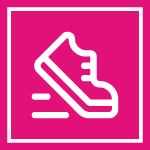Open a local street to everything but car traffic and play and enjoy the space safely. Play Streets and Open Streets have been a huge success in many areas. Be sure to coordinate with your municipal/town council.
Make it more active – Though already active, there are ways to encourage ongoing movement as a result of these events. For example, ask local walking leaders or local gardening group representative to set up a booth to meet people and invite others to join the groups; launch an activity challenge; provide maps of local playgrounds and walking pathways; offer bicycle repair and/or maintenance advice onsite; provide a demonstration of active games to play with kids; promote local equipment loan programs; connect the events with other sustainable placemaking ideas, such as the launch of new sensory pathways or new community based walking groups.
















































